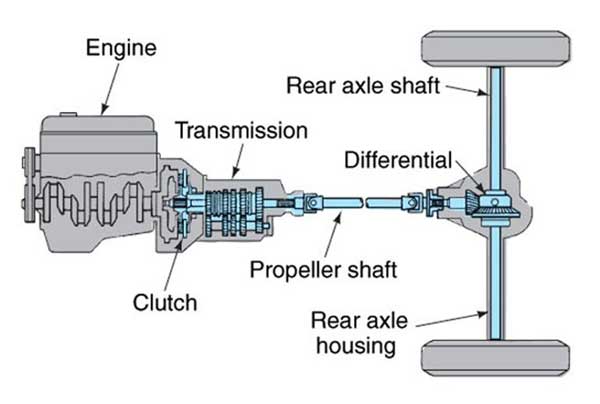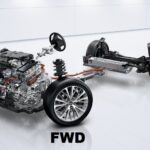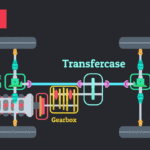
Advantages of Rear Wheel Drive-
1. Better handling in dry conditions – accelerating force is applied to the rear wheels, on which the down force increases, due to load transfer in acceleration, making the rear tires better able to take simultaneous acceleration and curving than the front tires.
2. More predictable steering in low traction conditions (ie: ice or gravel) because the steering wheels maintain traction and the ability to affect the motion of the vehicle even if the drive wheels are slipping.
3. Less costly and easier maintenance – Rear wheel drive is mechanically simpler and typically does not involve packing as many parts into as small a space as does front wheel drive, thus requiring less disassembly or specialized tools in order to replace parts.
4. No torque steer.
5. Even weight distribution – The division of weight between the front and rear wheels has a significant impact on a car’s handling, and it is much easier to get a 50/50 weight distribution in a rear wheel drive car than in a front wheel drive car, as more of the engine can lie between the front and rear wheels (in the case of a mid engine layout, the entire engine), and the transmission is moved much farther back.
6. Steering radius – As no complicated drive shaft joints are required at the front wheels, it is possible to turn them further than would be possible using front wheel drive, resulting in a smaller steering radius.
7. Towing – Rear wheel drive puts the wheels which are pulling the load closer to the point where a trailer articulates, helping steering, especially for large loads.
8. Weight transfer during acceleration. (During heavy acceleration, the front end rises, and more weight is placed on the rear, or driving wheels).
9. Drifting – Drifting is a controlled skid, where the rear wheels break free from the pavement as they spin, allowing the rear end of the car to move freely left and right. This is of course easier to do on slippery surfaces. Severe damage and wear to tires and mechanical components can result from drifting on dry asphalt. Drifting can be used to help in cornering quickly, or in turning the car around in a very small space. Many enthusiasts make a sport of drifting, and will drift just for the sake of drifting. Drifting requires a great deal of skill, and is not recommended for most drivers. It should be mentioned that front wheel drive and four wheel drive cars may also drift, but only with much more difficulty. When front wheel drive cars drift, the driver usually pulls on the emergency brake in order for the back wheels to stop and thus skid. This technique is also used for ‘long’ drifts, where the turn is accomplished by pulling the e-brake while turning the steering wheel to the direction the driver desires. With drifting, there is also the importance of ‘counter-steering’ – where while temporarily out of control, the driver regains it by turning the wheel in the opposite direction and thus preparing for the next turn or straight-away.
Disadvantages of Rear Wheel Drive-
1. More difficult to master – While the handling characteristics of rear-wheel drive may be more fun for some drivers, for others having rear wheel drive is less intuitive. The unique driving dynamics of rear wheel drive typically do not create a problem when used on vehicles that also offer electronic stability control and traction control.
2. Decreased interior space – This isn’t an issue in a vehicle with a ladder frame like a pickup truck, where the space used by the drive line is unusable for passengers or cargo. But in a passenger car, rear wheel drive means: Less front leg room (the transmission tunnel takes up a lot of space between the driver and front passenger), less leg room for center rear passengers (due to the tunnel needed for the drive shaft), and sometimes less trunk space (since there is also more hardware that must be placed underneath the trunk).
3. Increased weight – The drive shaft, which connects the engine at the front to the drive axle in the back, adds weight. There is extra sheet metal to form the transmission tunnel. A rear wheel drive car will weigh slightly more than a comparable front wheel drive car, but less than four wheel drive.
4. Higher purchase price – Due to the added cost of materials, rear wheel drive is typically slightly more expensive to purchase than a comparable front wheel drive vehicle. This might also be explained by production volumes, however. Rear drive is typically the platform for luxury performance vehicles, which makes read drive appear to be more expensive. In reality, even luxury performance front drive vehicles are more expensive than average.
5. More difficult handling on low grip surfaces (wet road, ice, snow, gravel…) as the car is pushed rather than pulled. In modern rear drive cars, this disadvantage is offset by electronic stability control and traction control.


